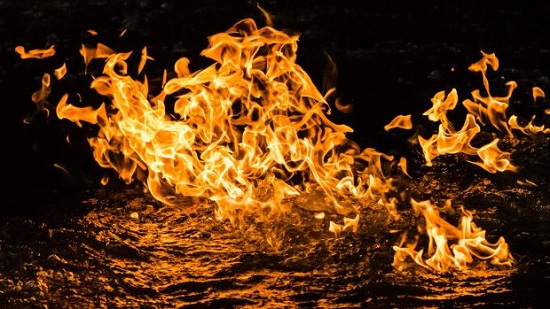NSW Greens Upper House politician Jeremy Buckingham set methane bubbling up in the Condamine River alight, making a video which went viral with 2.2m views from Friday to Sunday. The CSIRO had previously investigated the area and found the methane leakage was probably natural.
Buckingham knows better and accused the CSIRO of “making excuses” for the coal seam gas industry.

This is what Professor Damian Barrett, research director of the CSIRO’s onshore gas program says:
- Barrett said evidence from the CSIRO’s study suggested it was “unlikely” the increased gas seepage was caused by the coal seam gas industry.
“It’s not to rule it out completely, but we don’t see a direct connection, a direct relationship, between what’s happening on the gas fields up to this point in time and what’s happening in the river,” he said.
Advertisement
“The nature of the way those coals are laid down … those beds are discontinuous, they don’t tend to form natural connections.
“There could be a connectivity, a pathway there, but if there was it would be highly unusual.”
Barrett said it was not an “unusual occurrence” for that part of the river to hold a flame if it was not flowing, although lighting it was “not necessarily an advisable thing to do”, and said there were a number of places in the world – notably the Eternal Flame Falls in Shale Creek Preserve in upstate New York – that could hold a flame for most of the year.
There was also this explanation from the CSIRO:
- Barrett said the amount of gas seeping in that area had markedly increased in the past 12 months, a trend he said could be caused by a shift in sediment from the river bed, which would mean the gas was less dispersed, or could be the result of water that rushed into the alluvial aquifer during the 2011 Queensland floods slowly depleting, which would release the pressure and allow more methane to come to the surface.
There are reports also at the Brisbane Times and at the ABC.
In the latter Barrett says succinctly:
-
“The isotopic signature is telling us it’s coming from coal at that point in the landscape but coal is quite close to the surface and there’s a naturally existing small fault line, which cuts the river at that point,” he said.
Soon after the increased bubbling was first reported in 2012, geologist Gavin Mudd did a piece in The Conversation explaining the setup. Essentially the CSG is found in the Walloon Coal Measures, the coal-bearing aquifers which mostly lie below the Condamine Alluvium, the groundwater aquifers used for stock, agriculture and even human consumption. The Coal Measures and the Condamine Alluvium are mostly separated by layers of sandstone. Extracting CSG is done by dewatering the coal bearing aquifers. The biggest risk is that with the reduction in pressure in the coal aquifers, fissures can develop which drain or depressurise the useful groundwater aquifers.
Mudd’s opinion in this case was that “there is clearly a technically plausible process for CSG activities to be a factor in the methane gas now bubbling to the surface – either wholly or in part.”
He would find it hard to believe that the CSG had nothing to do with the bubbling.
The CSIRO have said they can’t be sure, but there is a plausible natural explanation and that the involvement of CSG is unlikely. There are also reasons why it is increasing and may have not been observed before by local farmers.
I understand that gas bubbles have been observed for many years in parts of the Condamine and it is part of traditional Aboriginal knowledge. I’m not sure about the exact site where it’s happening now.
On the issues of uncertainty and risk with CSG mining, have a look at my post at Larvatus Prodeo (especially the pictures), where I quoted John Helmuth:
- When a well is drilled information about the geology is gathered. However, no certain information can be gained about the existence of “geological flaws, fissures, faults, joints and planes of weaknesses, load and relaxation cracks” between the wells.
Nevertheless the CSIRO have assessed the area and find a connection with CSG mining unlikely.
I don’t know whether fracking has been employed in the area, but I doubt it.
The coal seam gas industry is basically evil, but Buckingham shouldn’t shouldn’t make damaging allegations about the honesty of scientists unless he is very sure of his ground and has science rather than stunts to back them up.
Update:
I thought I might include here some links to earlier work. Some of us did quite a lot back in 2012 under the banner of FAQ Research in a joint project with Crikey. At the main link you will find further links to research articles, film interviews, blog posts and photo essays.
Robert Merkel did an overview paper:
Here’s some of my stuff, before and during the FAQ project:
- Coal seam gas prospects: economic bonanza or future industrial wasteland? (2010)
CSG and the land: straight from the farmers’ mouths
Finally Mark’s 2013 post Coal Seam Gas, Four Corners, and failed governance has direct relevance to the present issue, see especially the comments thread.
I’ll stick with ‘don’t know’. It’s possible there is a connection with CSG. Maybe, maybe not.
I don’t think, however, that Buckingham has a warrant to accuse Barrett of being a mining industry apologist.


Dill
The Condamine is on Eastern edge of massive gasfield with wells located within 1 km of Co famine River. The industry has de-watered the coal seam extensively causing free methane to bleed out. The coal seam rises from west to east with highest point (closest to surface) directly under the river. There is no doubt the gas field has caused this.
It seems “within 1km” is actually 900m, which is still a fair way. Also:
I don’t see that this adds up to “there is no doubt”.
Do you happen to know whether there was fracking in the nearby wells?
Anyway, thanks for the information, but please don’t be rude.
I thought I might include here some links to earlier work. Some of us did quite a lot back in 2012 under the banner of FAQ Research in a joint project with Crikey. At the main link you will find further links to research articles, film interviews, blog posts and photo essays.
Robert Merkel did an overview paper:
CSG: what is it, where does it come from, and why is it so controversial?
Here’s some of my stuff, before and during the FAQ project:
Coal seam gas prospects: economic bonanza or future industrial wasteland? (2010)
CSG and the land: straight from the farmers’ mouths
Behind the Seams: Agriculture, land use and aquifers
How much water is produced with CSG?
Finally Mark’s 2013 post Coal Seam Gas, Four Corners, and failed governance has direct relevance to the present issue, see especially the comments thread.
I’ll stick with ‘don’t know’. It’s possible there is a connection with CSG. Maybe, maybe not.
I don’t think, however, that Buckingham has a warrant to accuse Barrett of being a mining industry apologist.
Brian: Thanks for this concise and informative article.
Having seen political and business pressure on scientists to come up with the most convenient answers – elsewhere and at another time – I am not surprised.
I do wonder if the heavy investment in current underground gas technology might stifle the development of far less harmful ways of extracting that gas. Sadly, not all the economists’ assumptions about rationality and profit-seeking survive out in the real world with its range of perverse and counterproductive behaviours.
oops. Kindly delete ” …. do not always ….”
[Done – Brian]